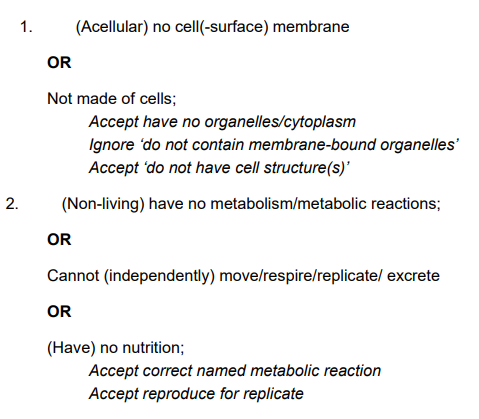3.2.1.2 - structure of prokaryotic cells and of viruses
1/27
There's no tags or description
Looks like no tags are added yet.
Name | Mastery | Learn | Test | Matching | Spaced |
|---|
No study sessions yet.
28 Terms
prokaryotic cells are m____ s_________ than eukaryotic cells.
prokaryotic cells are much smaller than eukaryotic cells.
in a prokaryotic cell’s cytoplasm, are there any membrane-bound organelles?
no
what type of ribosome do prokaryotic cells have
70s ribosomes (smaller than the ribosomes (80s) in eukaryotic cells)
do prokaryotic cells have a nucleus?
what do they have instead?
no
a single circular DNA molecule that is free in the cytoplasm and is not associated with proteins (learn this wording - straight from spec!)
what does the single loop of DNA contain
genetic info for an organism’s characteristics, development, growth, function + reproduction (CDRFG)
do prokaryotic cells have a cell wall?
what is this made of?
what is this?
yes
murein (note: in exam Qs, always specifiy what the cell wall is made of, depending on what type of cell it is from)
a glycoprotein
some prokaryotes (not all, mainly bacterium) contain one or more plasmids. what are these?
small rings of DNA
what do plasmids DO
carry genes that provide bacteria with advantages so they can survive in harsh environments
e.g. resistance to antibiotics / toxins
some plasmids contain g_____ that enable bacteria to c______ d_________ by producing t______ that help them i______ h____ c_____
some plasmids contain genes that enable bacteria to cause disease by producing toxins that help them infect host cells
some prokaryotes (not all) have a slime capsule.
this provides extra protection from…
…being engulfed by phagocytes, viruses (and drying out!)
the slime capsule also helps the cell s_____ t__ s_________ (e.g. the h____ c____)
stick to surfaces (e.g. the host cell)
what can the slime capsule help trap
nutrients for the bacteria
some prokaryotes (not all) can have one or more of a tail-like structure. what is this called
flagella (plu.)
what is the function of the flagella
helps w/ mobility / movement, esp. through liquids
viruses are a_________ and n___- l________.
viruses are acellular and non-living.
why are viruses non-living
because they are not cells, they are more like biological parasites. they are only active when they invade a host cell
why is a virus not a cell
not made of cells —→ has no organelles
has no metabolism —→ can’t produce energy / carry out chemical reactions on its own
cannot independently replicate —→ requires a host cell
has no nutrition (whatever that means…)
are viruses bigger or smaller than bacteria
much smaller
what are the 3 structural properties the most basic viruses have?
genetic material
capsid (protein coat)
attachment proteins
can a virus contain both DNA and RNA?
no - every virus contains DNA OR RNA (never just one or the other)
what does the capsid do
surrounds and protects the genetic material from the environment
where do attachment proteins protrude from?
what do they allow the virus to do?
the surface of the capsid (or if the virus has an additional, optional envelope, then that)
attach / binds to specific receptors on the host cell
what does the genetic material do
codes for (viral) protein
some viruses MAY have a lipid envelope. what is this?
an outer membrane containing viral proteins and phospholipids
EXAM Q: name 2 structures found in all bacteria that are not found in plant cells (2)
ANY 2 FROM:
circular loop of DNA
murein cell wall (have to say murein!)
70s ribosomes
EXAM Q: Describe one difference between the structure of DNA in a prokaryotic cell and in a eukaryotic cell. (1)
(In prokaryotes) Circular not linear
OR Not associated with proteins/histones
OR No introns;
Ignore ‘loop’
Ignore ‘plasmid’
EXAM Q: how the appearance of DNA in a TEM image of a prokaryotic cell (bacteria) would differ to that of a eukaryotic cell (2)
1. Nucleus;
2. Nucleolus/nucleoli
OR Nuclear membrane/envelope;
3. Mitochondria/chloroplast contain DNA; Accept ‘membrane bound nucleus’ = 2 marks
EXAM Q: Explain why viruses are described as acellular and non-living. (2)
